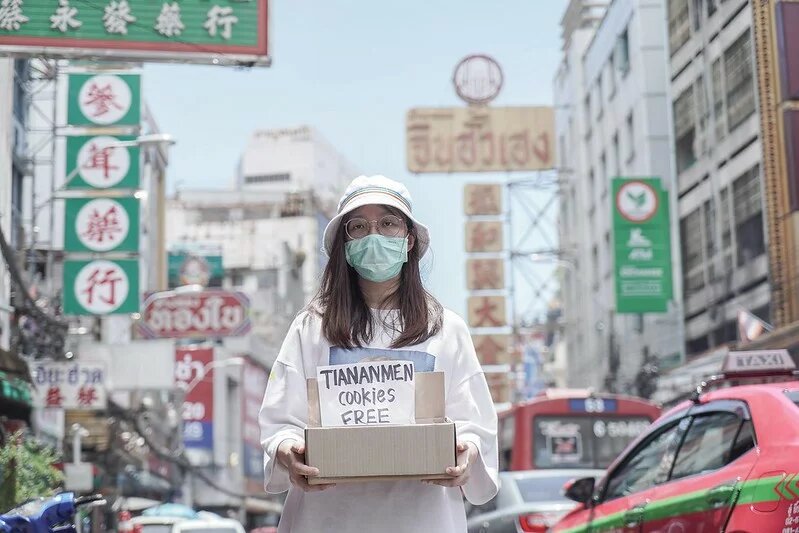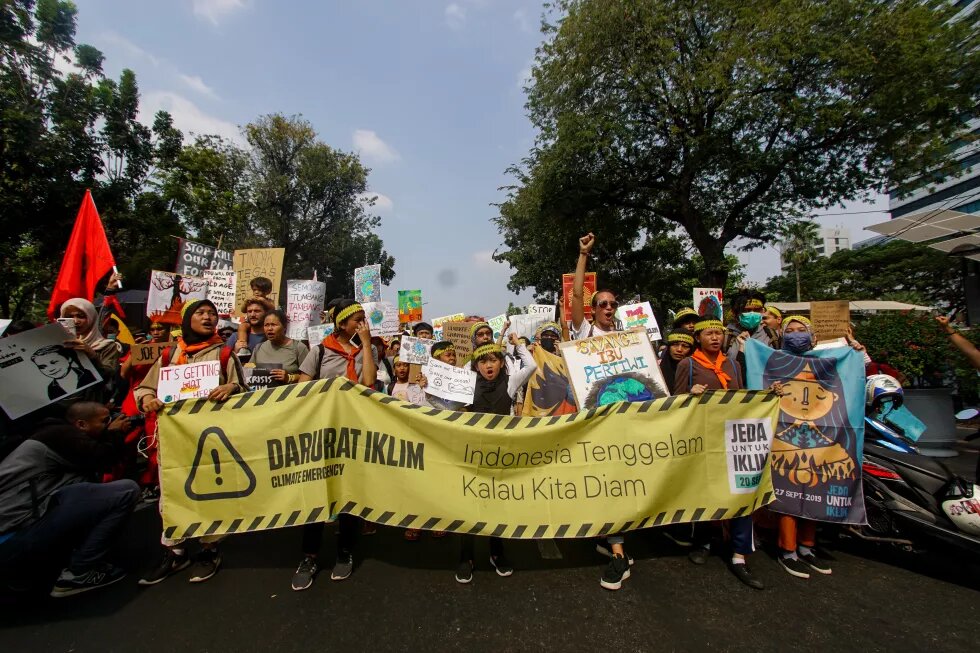
The global youth climate movement was building momentum in 2019 and then the COVID-19 pandemic hit. Despite the many challenges faced, new ways to campaign, protest and gain further awareness are creatively adapting to the circumstances. But we must also not forget the ongoing difficulties faced by youth in the Global South, who are dealing with everyday difficulties that impact on barriers to wider participation in the movement.

Since long ago, the youth movement has brought about change. It has escorted the previous society into a new era. In countries that were colonialized, youths were spearheading the struggle to realize independence for their people. In Asia, historical waves of youth uprisings have taken down decades of authoritarianism. While most discourses on the youth movement focus on major mobilizations in the Global North countries, the youth in the Global South covers about 90% of the total world youth population. What is the power of youth resistance here, and what are the challenges they face, considering their livelihood and the recent COVID-19 pandemic?
Let’s look back for a moment. In September 2019, roughly 7.6 million people participated in the global climate strikes through 4,500 actions organized in 150 countries. The mobilization is likely the highest-participation climate strike in history. The unique thing is that the youth-led these actions. This mobilization attracted public and media attention, mainly because the age range of demonstrators was getting younger. We saw kids as young as five years old marching in their cities. They took to the streets and shouted to their governments, demanding a livable planet, now and in the future.
Momentum and further connections
In March 2020, the momentum was disrupted by the COVID-19 pandemic. The movement’s core ability to attract and maintain supporters was put on hold. The physical isolation required in tackling the pandemic has presented a real challenge to the youth movement as it needs relationship-building en masse. However, the pandemic also brought the realization that all of us are somehow connected. And the digital world has helped that. The youth who are digital natives found themselves able to link up with their peers.
The organizing effort that previously took place in person is still being carried out digitally or physically but with health protocols. Capacity and knowledge building continues. Many communities and civil society organizations have risen to the challenge of communicating their campaigns better in the digital world. Civic mobilization platforms, such as change.org, avaaz.org, and crowdfunding platforms, also support the involvement of people across the world.
The creativity in the digital realm attracts many new players to the movement. K-pop fans who dominate social media often become part of the youth social movement. Blackpink, the superstar female band, called for "Climate Action in Your Area" in the series leading up to COP 27 in Glasgow, and certainly gained the attention of many of its fans.
COVID-19 hasn’t stopped young people from taking to the streets and raising their voices. In Indonesia, for example, 346 nonviolent direct actions throughout 2020 were noted [1], mostly pressuring the government to cancel the legislation process for the Job Creation Law that deregulates investment in the country. In Asia, we witness the youth-led solidarity efforts to support Hong Kong independence from mainland China spread out online under the ‘Milk Tea Alliance hashtag. In the climate movement, the seeds planted on global climate strikes have grown into a plethora of youth climate groups under many names. The most prominent group is Extinction Rebellion and Fridays for Future, which are starting to emerge further and gain more membership in Global South countries.
But can this youth movement bring about the desired social changes? in Indonesia, it appears that student protests against predatory laws were being ignored. The new Mineral and Coal Mining Law and the Job Creation Law continued to be enacted during the pandemic, despite the large wave of protests. In Myanmar, military power is even more rampant. Recently, in the Philippines, a dictator’s son was elected president, defeating another strong candidate with support from grassroots youth networks.
The 3.5% rule
It turns out, the recent mobilizations did not involve enough large-scale participation to tip the balance towards social change. Prof. Erica Chynoweth of Harvard Kennedy School pointed out that we need 3.5% of the population to be actively engaged in peak events like mass mobilization to alter national governments. This is a surprising number in a democracy that upholds the idea that the majority rules. But behind the 3.5% of constituencies that participate in the demonstration, more people support the position.
In addition to extensive mass participation, community-driven political changes can occur if there are various tactics, clarity of strategy, loyalty shifts, and resilience to repression. These aspects can be managed if a movement is well-organized and prepared for a long-term struggle. Before peak events occur, a disciplined campaign vision needs to be planted. This can be seen through the example of the struggle of Serbian activists in the Otpor movement, who said that 95% of their efforts were spent on planning, preparation, distribution of action and absorption of the movement.Only 5% of the effort went to the actions themselves.
Without doubt, the key activities above have been hampered by the pandemic. Because many meetings are held in the digital realm, they are less engaging, and building the mass connectedness necessary for a solid movement becomes more challenging. The pandemic has also widened the already existing economic disparity, which plays some role in the reality of the youth in the global South.
The resourceful youth of the Global South
The main trait of most Southern youth is the habit of hustling as a way to navigate the prevalence of precarious circumstances. They constantly have had to improvise and adapt to changes in conditions and livelihoods. Southern youth generally experience increased population density, greater competition for opportunities, higher levels of income poverty, unemployment and inequality, lower standards of living, and often higher rates of crime and state-induced violence.
We should note that this does not mean that young people in Global Northern countries do not face these difficulties. However, the magnitude of the issues there is not the same as what happens in the Global South. For example, only “less than 2% of people living in Europe, North America, and Australasia live off less than US$2 per day, while upward of 40% of people in almost all African countries and developing Asian countries live on less than this amount.” With such a wide gap, the ammunition possessed by young people from Global South countries facing their existing challenges is far more limited.
Thus the young people who enter the arena of the movement in the Global South are more likely to be educated middle-class youth who have autonomy in voicing their aspirations, not yet having to wrestle with dire economic needs. They tend to have formal education and live in urban areas. This is evident in the climate movement in the Global South that lives and thrives in urban environments.
We must be aware of this tendency. Otherwise, the consequences are at least twofold. First, we tend to overestimate the people power that has been built up among young people. We are blind to the large population of underprivileged youth as they are not reflected in political literature and mainstream media, so we, unintentionally, exclude them. Second, we become ignorant of their true power and creativity due to being accustomed to innovating in the face of uncertainties.
Economic, cultural and social justice at the Intersection
Currently, the youth-led movement is mainly carried out by educated young people in big cities. They act because of identity and self-actualization. They outnumbered young activists who started or joined a movement because they needed the impact as extractive industries threatened their homeland. We need to turn this around to achieve the 3.5% rule. As a catalyst of peaceful resistance, the youth climate movement has to ground itself to answer the challenges of economic and social inequality.
Building a climate movement thus must embrace the class struggle driven by workers and the struggle for land carried out by farmers' unions and Indigenous peoples. It has to align with the battle against discrimination against women, the disabled, and other minority groups. The urban youth movement must ensure that those excluded are the first to have their voices heard. The struggle for the future is also a struggle to adapt to various phenomena of injustice that have been faced by people who are marginalized.
We see that the disadvantaged are victims of multiple unfair systems that interact with one another. The climate crisis is a by-product of social, economic, cultural, and political inequalities and injustices. Therefore, we should approach solutions to climate change from a wider angle and combine different movements. This is also widely referred to as intersectionality. In recent years this topic has become increasingly popular among progressives in Western countries.
However, I observe a slight difference between the intersectionality in the Global North and the Global South. In the Northern countries, intersectionality emphasises civil and political rights, emphasising individual freedoms. In the least developed countries, intersectionality highlights economic, cultural, and social rights that require a higher level of investment from the states.
Without being made explicit, the environmental movement in the south has always been intersectional. For example, forest protection efforts are advocated through measures to fulfil the rights of indigenous peoples who have been proven as forest guardians from generation to generation. And vice versa, conservation efforts in the developing world that do not seek to protect forest-dependent people will inevitably fail in their implementation.
A way forward
The youth movement in the Global South must not stop as a phenomenon. It needs to be nurtured continuously until there is a transformation that is just and rooted in the identity of their nations. With climate catastrophe in the background, they need to strive for a deep decarbonized society with a community-driven solution on a large scale.
This is a big challenge because COVID-19 has made the economic gap even wider, where the concentration of wealth by fewer and fewer people has also strengthened. The struggle for intergenerational justice must target corrupt and greedy actors in the extractive sector today who are exploiting indefinitely, leaving behind disasters in the future. Therefore, the youth climate movement must merge with the struggles of other marginalized groups and build broader solidarity.
The movements in developing countries have extensive homework to achieve the critical mass needed. Therefore, civil societies must cultivate their community-organizing muscles to grow a broad movement that is not quickly broken. There must be a sharp awareness of what to aim for and how we get there. The form and construction of the movement of power must be in accordance with the laws and conditions of society. There is no standard formula. But the reflection-action cycle is a necessity. All movements learn from each other's actions and ride on each other.
Ultimately, growing a movement is about building relationships with a clear goal of change. The carriage of the youth movement needs to be continuously supported, without forgetting the context of economic inequality they must face. It is difficult to contribute to a movement when you are struggling, hungry and unemployed. For the climate and environmental movement, it is essential to address the fundamental aspects of civil, political, economic and social justice faced by most young people in the Global South.
__
Sisilia Nurmala Dewi is the Asia Managing Director (Interim) of 350.org
The views expressed in this article are not necessarily those of Heinrich Böll Stiftung




